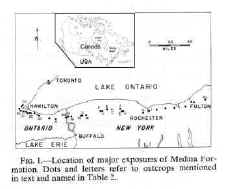The American Association of Petroleum Geologists Bulletin, Vol. 55, No.8
(1971), 1249-1261
REGIONAL ANALYSIS OF SEDIMENTOLOGY OF MEDINA FORMATION (SILURIAN), ONTARIO
AND NEW YORK
I.P. MARTINI
Department of Land Resource Science, University of Guelph, Guelph, Ontario
¡¡
 The sedimentological characteristics of the Medina Formation (Silurian) were
examined in the sections exposed along the Niagara escarpment in Ontario and New
York. The vertical and lateral variations of the textures, fabrics, sedimentary
structures, and faunal assemblages indicate a mixed environment of deposition
best explained by a deltaic-shallow marine model of sedimentation. The growth of
the Medina clastic sequence was related to shifting deltas which. Locally,
reached the area cut by the natural cross section of the Niagara escarpment. The
primary constructive phases of these Medina deltas are well developed in the
vicinity of Fulton and between Medina City and Rochester, New York. A third area
of direct deltaic clastic input in the Medina sea is present in parts of the
DeCew and Niagara Gorge sections. In the Niagara- Ontario area, however, the
marine forces were competent enough to rework and redistribute most of the
delta-born sediments. The combination of a relatively slow rate of clastic
input, a shallow Silurian sea, and a very slow subsidence of the depositional
basin yielded a complex interfingering of deltaic topset environments and of
prodelta and/or interdeltaic environments. The tops et to shoreline environments
are characterized by channel sedimentation, beaches, tidal flats as demonstrated
by the presence of Lingula shells still in living position-and high tidal
flats to floodplain settings where burrowing organisms flourished. The prodelta
parts of the deltas, or the more open-marine environments, are represented by
the dolomites and the gray and red shaly and silty sequences with minor
carbonates, which compose the Medina sections in the Hamilton area and which
thin eastward and pinch out in the vicinity of Medina City, New York.
The sedimentological characteristics of the Medina Formation (Silurian) were
examined in the sections exposed along the Niagara escarpment in Ontario and New
York. The vertical and lateral variations of the textures, fabrics, sedimentary
structures, and faunal assemblages indicate a mixed environment of deposition
best explained by a deltaic-shallow marine model of sedimentation. The growth of
the Medina clastic sequence was related to shifting deltas which. Locally,
reached the area cut by the natural cross section of the Niagara escarpment. The
primary constructive phases of these Medina deltas are well developed in the
vicinity of Fulton and between Medina City and Rochester, New York. A third area
of direct deltaic clastic input in the Medina sea is present in parts of the
DeCew and Niagara Gorge sections. In the Niagara- Ontario area, however, the
marine forces were competent enough to rework and redistribute most of the
delta-born sediments. The combination of a relatively slow rate of clastic
input, a shallow Silurian sea, and a very slow subsidence of the depositional
basin yielded a complex interfingering of deltaic topset environments and of
prodelta and/or interdeltaic environments. The tops et to shoreline environments
are characterized by channel sedimentation, beaches, tidal flats as demonstrated
by the presence of Lingula shells still in living position-and high tidal
flats to floodplain settings where burrowing organisms flourished. The prodelta
parts of the deltas, or the more open-marine environments, are represented by
the dolomites and the gray and red shaly and silty sequences with minor
carbonates, which compose the Medina sections in the Hamilton area and which
thin eastward and pinch out in the vicinity of Medina City, New York.
The Medina Formation is
gas productive directly south of the outcrop section, and the constructed
sedimentation model can be of value to predict the best reservoir trends in the
subsurface.